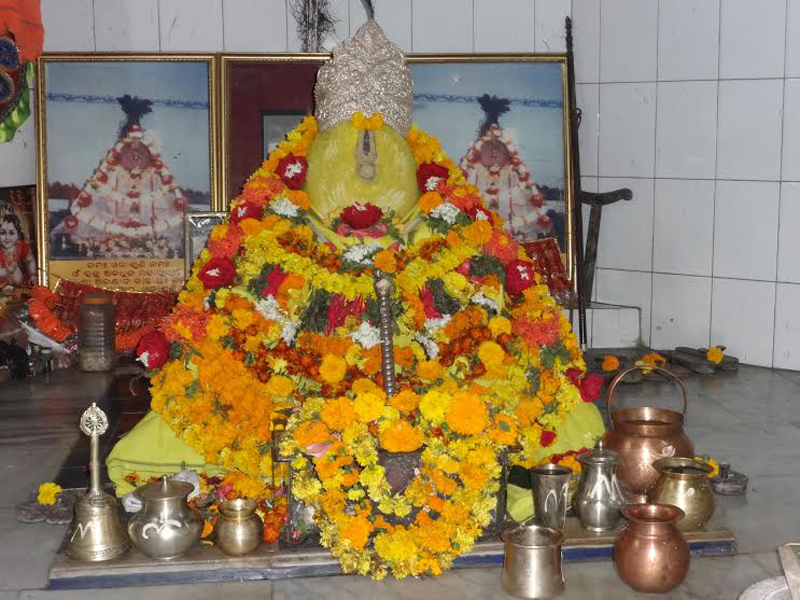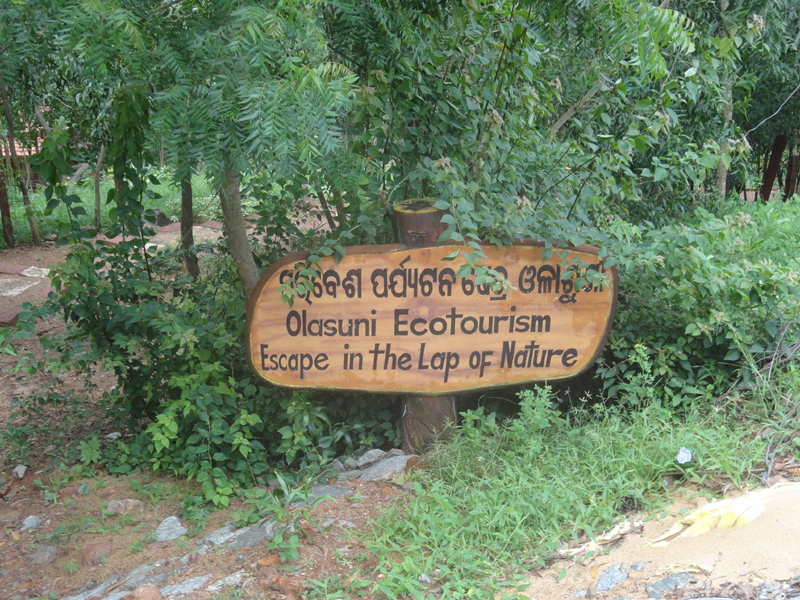The sacred land of Odisha is enriched by development in both Puranic and historical sites and monuments of Brahmanic, Buddhist, Jain, Islamic and Christian faiths.
In addition to the Temples, Pagodas, Buddhist temples, and Jaina Relicsm, the Islam and Christian historic sites of Odisha also produce an ancient and important cultural, religious, and sanctuary shrine named “Gumpha Dhama” in disguise of a world-famous ancient Buddhist site from the 1st century BC or AD, converted into a Hindu shrine from the 12th and 13th centuries AD, known as “Olasuni pitha”.
Located between the world-famous Buddhist sites of Lalitgiri and Udayagiri in the undivided Cuttack District of Odisha, lies the Beautiful Abode and Mahaprayan Khetra or the Place of Salvation of Bramha Darshi- Mahapurusa-Avadhuta-santha Arakhita Das.
The world-famous “Olasuni Gumpha” is the holy site of perfection and the Santha Arakhita Das Mahasamadhi Temple is located on a hilltop “” next to the left bank of the cascading Gomati River.
The site is of great archaeological and historical interest, but it is beyond the experience of explorers, academics and historians.
Olasuni Temple
The very location of the hill, Gumpha or Pahada, is named after the four-handed Buddhist goddess Prajnaparamita, who became the goddess of Hinduism and was renamed Devi by the local people.
Akshyamala and a Khanda (sword) are carried by the goddess in the raised right and left hands and Dharmachakra Pravartana Mudra in the main pair of hands. The Buddhist monks worshiped the goddess within the gumpha known as or Sidha Gumpha until the 12th/&13th century AD. In the later period, with the decline of Buddhism, the hillock was covered by hanging banyan tree trunks, known as Bara Ohala.

Maybe the local people referred to this hillock as Ohalasuni, later transformed into Olasuni, according to the word Ohala, the hanging state.
The goddess has been generally known since that time as Olasuni Devi and the Cave, as Olasuni gumpha and Olasuni pahada hillock.
The hillock was also called “Olasuni Pahada” even after the arrival of Santha Arakhita in the 18th century A.D, as Arakhita Das composed in his bhajan, with an apple for the goddess “Olasuni Giribara.” The hillock has since been called Olasuni Gumpha Pahada.
The temple is constructed from the Khondalite stone obtained from this hillside.
You can read our another post on The Leaning Temple of Huma: A Unique Architectural Wonder
Historical Background
The Holy Arakshit Das (alias Yuvaraj Balabhadra Dev) was born in the eighteenth century to the Royal Family of Bada Khemundi (undivided Ganjam) in the Ganga Dynasty. He travelled across the Kalinga (Orissa) to get a perfect place for meditation as he is very fond of religious practices and a God-loving human.
He went to the famous Sarala Shakti Peeth, Jadupur, Paradeep, Kujanga’s Sandha Raja, and many more places; but he came to Olasuni Cave after a lot of frustration and chaos, which was under the famous Kendrapara Ruler Radhashyam Narendra. He retained his request and was permitted to reside there. Finally, he selected the hill of Olasuni as his ‘sadhana pitha.’ He then began to worship the Goddess and meditated on a hill there.
The hill was filled with forests at the time and people seldom visited the hill in fear of the Olasuni Chandi, the Virago who was believed to live there.
Legend has been that Lord Jagannath ordered Arakhita, in a dream, to play the flute he brought from Brindaban (which Shri Krishna gave). Goddess Olasuni was delighted when he played the flute and went down to the bottom of the hill. Santha Arakhita Das practiced “Omkara Yoga” in Olasuni or Sidha Gumpha, and as a “Bramha Avadhuta” great.
On Magha, Krushna, Ekadashi (January 19, 1837), Shri Arakshit Das, while meditating, rested his soul in the cave.
The ‘Olasuni Cave Festival’ has been held every year for over a hundred years to worship the Goddess and to continue memorizing the famous Saint Shri Arakshit Das.
For a week, people from all over Odisha came here during the festival to give the ‘Podha Peetha’ (a burnt-cake made with rice and other cereals) at the Saint’s cemetery and drink the healing ‘Kanjipani’ offered by the mutt.
Prasad Served
The devotees are permitted to give any kind of food to the deity, according to the dictum of the saint, as the saint considered all food products eaten by human beings as ‘prasad.’ As per local custom, before the deities at the cave shrine, fruits and vegetarian food are provided as ‘bhog’.
Poda Pitha (a kind of Odia pancake), Sukua (dried fish) and Somarasa (wine) are also given to him by his followers as offerings. The most famous Prasad at the temple is Kanjipani (a yellowish liquid extract of rice gruel). Individuals think that its healing properties help cure many illnesses.
Olasuni Fair
Olasuni Fair is known as “Olasuni Gumpha Mela” in general. It is a very popular fair that happens all over Odisha.
As the name suggests for Goddess Olasuni, the fair is actually only for Santha Arakhita Das. The fair begins on Magha Krushna Ekadasi’s auspicious day which is Santha Arakhita Das’s Mahasamadhi Day and ends on Vasant Panchami (Saraswati Puja).
Sleepy Hill Olasuni comes alive with the advent of Magha Ekadasi, offering a plethora of devotional and cultural events. To participate in the cave festival (Gumpha Yatra) and receive the blessing of Santha Arakhita Das, thousands of devotees from far and wide throng here. To mark the death anniversary, or Shradha Mahotsav of the Mahapurusha Santha Arakhita Das, the cave festival is celebrated.
While the traditional festival is celebrated for a day, both from a tourist and commercial point of view, the fair continues for a week and the stalls of Lalitgiri and Sukhuapada’s stone engraved works, in particular, remain open for publication for more than a fortnight.
In addition to setting up a guest house and park, the State Government has also provided permanent roads, electricity and water supplies to Olasuni Hill to increase the tourism potential of the area.
However, for the sake of ‘Abadhutabada’, the festival is no longer the same as it used to be. Particularly for the youth community, the place is becoming a haunt where they can make merry by eating liquor, Bhang and openly smoking Ganja at the festival. In comparison, the conventional Bhajan and Kirtan easily lose their originality on the hill. Instead the festival reduces modern melody, opera troupe services and thousands of market stalls on the pedestal of the hill to a commercial fair.
Just as the Olasuni hill is at the crossing point of the three districts of Cuttack, Jajpur and Kendrapara, so the fair holds thousands of people every night. Everyone enjoys the various kinds of food, household goods, magic shows, circus, Jatra (theater program) and all that a nice fair comprises.
It is also a very popular tourist spot, so as the fair experienced in the picnic month (January-February) every year enhances the gathering of tourists, not only people from different corners of Odisha come, but also many foreigners come to fall in love with this great place to witness the cultural diversity and heritage of Odisha.

How to Reach
Olasuni temple is just 20 km from Chandikhol and 60 km from Cuttack city. You need to get down at Bandareshwar Palai Chhak when approaching from Cuttack towards Chandikhol, Kendrapara, and take an auto-rickshaw to the destination for just a 2 km ride. By hiring a taxi, one can approach Chandikhol and Balichandrapur. Cuttack is the closest railway station you can reach here by.
